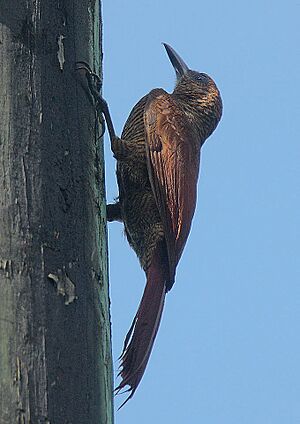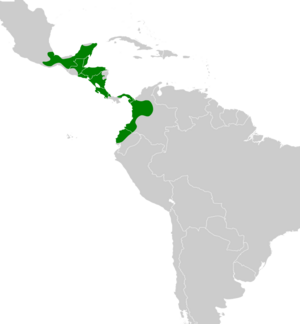Northern barred woodcreeper facts for kids
Quick facts for kids Northern barred woodcreeper |
|
|---|---|
 |
|
| Conservation status | |
| Scientific classification (See Taxonomy and Status sections) |
|
| Genus: |
Dendrocolaptes
|
| Species: |
sanctithomae
|
 |
|
| Range of northern barred woodcreeper excluding D. s. punctipectus | |
| Synonyms | |
|
Dendrocolaptes certhia sanctithomae |
|
The northern barred woodcreeper (Dendrocolaptes sanctithomae) is a cool bird that lives in forests from southern Mexico all the way through Central America to countries like Colombia, Venezuela, and Ecuador. It's part of the ovenbird family, which is known for building interesting nests. This bird is a type of woodcreeper, meaning it often climbs up tree trunks looking for food.
Contents
About the Northern Barred Woodcreeper
How Scientists Classify This Bird
Scientists group living things into categories. This is called taxonomy. The northern barred woodcreeper was once thought to be the same species as the Amazonian barred woodcreeper. However, in the 1990s, scientists decided they were different species.
There are four main types, or subspecies, of the northern barred woodcreeper:
- D. s. sheffleri
- D. s. sanctithomae
- D. s. hesperius
- D. s. punctipectus
Some scientists think that D. s. punctipectus might even be its own separate species, called the eastern barred woodcreeper. But for now, most agree on the four subspecies.
What Does It Look Like?
The northern barred woodcreeper is one of the bigger birds in its family. It's a slim bird with a long tail and a straight bill that's not too long. Males have a shaggy crest on their heads.
These birds are about 25 to 29 centimeters (10 to 11 inches) long. Males usually weigh between 53 and 72 grams (1.9 to 2.5 ounces), while females are a bit heavier, from 54 to 83 grams (1.9 to 2.9 ounces). Both male and female birds look the same.
The most common type, D. s. sanctithomae, has a mostly cinnamon-brown face with thin stripes. Its forehead, crown, and the back of its neck are a rich reddish-brown. Its back and wing feathers are olive-brown, and its rump and tail are reddish-brown. The top of its head and back have black stripes.
Its chin, throat, and belly are a golden to cinnamon-yellow color with clear, narrow black stripes. Its eyes can be light or dark brown. Its bill is mostly blackish with lighter edges. Its legs and feet can be dark brown, black, grayish-green, bluish, or horn-colored. Young birds look similar to adults but have softer stripes on their bellies.
Other subspecies have slight differences in their colors and stripe patterns. For example, D. s. sheffleri has fewer stripes on its upper body and narrower stripes on its belly.
Where Does It Live?
The northern barred woodcreeper lives in different parts of Central and South America.
- D. s. sheffleri is found on the Pacific coast of southwestern Mexico.
- D. s. sanctithomae lives on the Caribbean coast from Mexico's Veracruz and Yucatán Peninsula, south through Belize, Guatemala, Honduras, Nicaragua, and Costa Rica into Panama. It also lives on the Pacific coast from Mexico's Chiapas, south through parts of Guatemala, El Salvador, Honduras, Nicaragua, Costa Rica, Panama, and northern Colombia into northwestern Ecuador.
- D. s. hesperius is found on the Pacific coast of southwestern Costa Rica and western Panama.
- D. s. punctipectus lives in northern Colombia and northwestern Venezuela.
This bird mostly lives in humid, tall evergreen forests. It can also be found in smaller forests, gallery forests (forests along rivers), and even mangroves. It prefers the deep parts of the forest but can also be seen at the edges, in older secondary forests (forests that have grown back after being cut down), and in plantations near natural forests. It usually lives in lowlands, below 1,000 meters (3,300 feet) in elevation.
Behavior and Life Cycle
How It Moves Around
The northern barred woodcreeper usually stays in the same area. However, after breeding, some birds might move from lower areas to higher elevations.
What Does It Eat?
This bird has a very interesting way of finding food! It mostly follows swarms of army ants. As the ants move, they disturb insects and other small creatures, making them easy for the woodcreeper to catch. The bird usually follows the ants alone or in pairs, but sometimes up to four birds can be seen at one ant swarm.
When it's with an ant swarm, the woodcreeper often perches on a tree trunk. It then makes short flights to grab prey from the ground, tree trunks, vines, leaves, or even in the air. It also sometimes hunts away from ant swarms, usually in the lower or middle parts of the forest. Its diet mainly includes arthropods like insects, spiders, centipedes, and scorpions. It also eats small vertebrates like lizards.
Reproduction and Nesting
The breeding season for the northern barred woodcreeper changes depending on where it lives. For example, in Costa Rica, it breeds between May and July, while in Colombia, it breeds from November to March.
This bird builds its nest fairly close to the ground. It finds a hollow in a tree trunk or a natural cavity, like one formed by a broken branch. It lines the nest with leaves and pieces of bark. A female usually lays two eggs. Both parents seem to help incubate the eggs, but scientists don't know all the details about how long the eggs take to hatch or how long the young birds stay in the nest.
What Does It Sound Like?
The northern barred woodcreeper sings mostly at dawn and dusk, but also sometimes during the day. The song of the "western" subspecies is a series of loud whistles that get higher at the end. People describe it in different ways, like "téw-wee, téw-wee, téw-weea" or "doh-wee, doh-wee, doh-wee, do-wee."
It also makes many different calls, such as "oiýnk," "awwýnk," "wi-kaíh," "caa," and a quiet "wh-whee."
The song of the "eastern" subspecies (D. s. punctipectus) is quite different from the others. Its whistles start flat and then become progressively higher in pitch. However, its calls seem to be the same as those of the other subspecies.
Conservation Status
The IUCN (International Union for Conservation of Nature) assesses the conservation status of species. They look at the "western" northern barred woodcreeper (the first three subspecies) and the "eastern" barred woodcreeper (D. s. punctipectus) separately.
The "western" complex is listed as being of Least Concern. This means it's not currently at high risk of disappearing. It lives in a large area, but its population size is unknown and is thought to be decreasing. No immediate threats have been found for this group.
The "eastern" subspecies is listed as Vulnerable. This means it faces a higher risk of becoming endangered. It lives in a smaller area, and its population is estimated to be between 2,500 and 10,000 adult birds. This population is also believed to be decreasing. The main threats to this subspecies are forests being cut down for timber and land being cleared for farming and ranching.
The "western" barred woodcreeper is generally uncommon to common in most places it lives. However, the "eastern" barred woodcreeper is considered one of the most threatened woodcreepers because of a lot of habitat destruction in its limited lowland range. It does live in some protected areas, both private and public.
Like most birds that follow ants, the northern barred woodcreeper needs a fairly large area to live in. It is sensitive to forests being broken up into smaller pieces and other human disturbances. It's also unlikely to move to new areas if there are barriers of unsuitable habitat.



